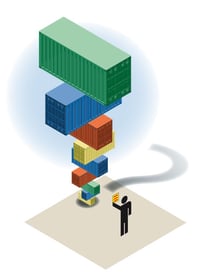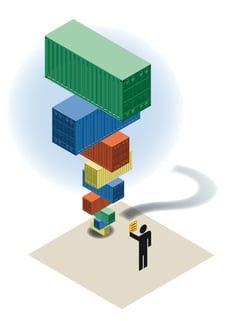The Model Strategy: Benefits of Enhanced Yard Container Management
Nick Ostdick - July 28, 2016

 My son recently received a model airplane kit as a birthday gift. He was so excited to put the model together, he tore into the box, tossed the component parts across his bedroom floor like confetti, and skimmed over the assembly instructions before trying to put the model together. However, he quickly discovered, in large part due to the disarray of the parts, how difficult assembly would be without creating some kind of plan or strategy for sorting the parts into the appropriate groups. He finally came to me for help and we spent a few minutes organizing the parts into small piles by trait or characteristic and where we assumed they’d be sequenced in the overall assembly.
My son recently received a model airplane kit as a birthday gift. He was so excited to put the model together, he tore into the box, tossed the component parts across his bedroom floor like confetti, and skimmed over the assembly instructions before trying to put the model together. However, he quickly discovered, in large part due to the disarray of the parts, how difficult assembly would be without creating some kind of plan or strategy for sorting the parts into the appropriate groups. He finally came to me for help and we spent a few minutes organizing the parts into small piles by trait or characteristic and where we assumed they’d be sequenced in the overall assembly.
It wasn’t long before we developed a smooth, efficient sequence of production aided by knowing which parts were in which piles, their proximity to us, and their overall importance in assembly.
Model airplanes aside, it occurred to me our method of sorting parts for optimal efficiency is not unlike the challenges OEMs face with improving their yard container management strategies.
Just like how my son and I needed to know the status of parts, quantity, and location based on the assembly instructions, automotive manufacturers need to know the status, holdings, location, and ease of availability of containers in the yard to ensure efficient production, sequencing, and demand planning strategies based on planned production programs.
Container yard management, like our sorting of model airplane parts, may seem like a tedious task, yet it’s a core driver for companies to leverage cost-effective, productivity-based production schedules and strategies, particularly in variant-rich industries with a network of production sites on a global scale.
Why Yard Container Management?
In today’s global supply chain, components and parts are ordered on a forecast basis or on non-fixed production plans. As such, this can create significant challenges in managing part inventories within storage containers as these non-fixed production plans are subject to change or modification, often times in transit between production facilities. Essentially, imagine the parts inside the model airplane box leaving the factory in adherence with the instructions only to discover the instructions have changed when you open the box at home.
Because of this shift in part priorities and demands, manufacturers are often faced with the question of: Which containers in the yard will provide the greatest coverage for production programs without resulting in overages, shortages, or other complications that could result in production disruptions or breakdowns?
In addition, companies must also decide which containers will be unloaded and when, in order to facilitate best practices in sequencing and production, to remain aligned with delivery timetables. To answer these questions, companies must ensure the right inventory of parts in the warehouse to meet demand for production - too much inventory can result in significant financial losses and lags in the usage of parts, and too little inventory can find companies dealing with production disruptions due to lack of necessary parts.
Yard container management solutions help determine which containers - the parts within those containers - should be pulled in order to meet demand planning needs and ensure cost-effective production programs for maximum efficiency. A yard container management solution provides planners and managers with a holistic, real-time view of the entire supply chain network with the ability to focus on certain parts of the value chain to detect and predict potential bottlenecks or disruptions and devise actions to avoid them. This capability also helps create a more lean supply strategy that enhances visibility, agility, and flexibility to help companies adapt to sudden, unforeseen changes in demand planning and production, which can be a saving grace for manufacturers in today’s global, interconnected supply stream.
Benefits of Yard Container Management
For my son and I, the benefits of knowing the location, quantity, and necessity of each part relative to the overall assembly significantly benefited the ease of assembly and the enjoyment of putting the model airplane together - it also helped reduce the number of frustration fits my son experienced, which greatly benefitted my eardrums. But looking at the automotive manufacturing and supply stream, the benefits of yard container management strategy and improving that strategy via an integrated solution can be a key driver in creating growth, enhancing productivity, and avoiding severe supply disruptions.
More specifically, companies that leverage a yard container management solution stand to benefit via:
Minimized warehouse inventory. By incorporating and optimizing a yard container management solution, companies can minimize inventory by selecting the appropriate containers and parts for demand planning coverage without including parts not immediately required by production programs. Using the pull principles, companies have the ability to take what they need from various containers and leave what they don’t, which increases cost-effectiveness and reduces the risk of overages in terms of unused stock.
Improved efficiency. A yard container management strategy allows companies to optimize the unloading of containers and become proactive in managing aging containers or those that are nearing the end of their lifecycle due to customer demands and restraints. This enhances a company’s overall management strategy and has ripple effects to the over efficiency and productivity of dock management, BOM management, PFEP (Plan for Every Part), and other elements of the overall production sequence.
More accurate demand planning. Understanding which containers to pull from, when, and why not only facilitates more efficient production programs, it can also help planners and managers create more effective demand planning strategies for future production. The ability to view the status of containers within the yard in real-time can be critical when determining the level to which a company can meet customer demand at any given manufacturing site. In addition, this degree of visibility is also key in planners deciding whether containers or the parts contained within need to be transported to other production sites based on customer demand or critical supply situations.
Yard Container Management = Success
Whether we’re talking my son and my airplane model assembly or the complexities of today’s global supply chain, it’s clear the ability to know which parts for what and when is vital to success. OEMs and auto manufacturers need to leverage yard container management as a core driver of their inventory and demand planning strategy to remain lean, cost-effective, and productive, especially given the intricate nature of today’s production network. In doing so, companies will be establishing best practices in production and supply that will help propel them into a profitable future.

LATEST POSTS
- Understand Circular Economy in The Manufacturing Industry
- How Can Industry 4.0 IT Integration Be Achieved Smoothly?
- The Significance of Order Sequencing in Discrete Manufacturing
- How to improve your Supply Chain Management: The Power of Control Towers
- Optimizing Human Resource Scheduling in Manufacturing: A Technological Approach


